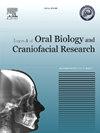树脂填充复合材料、常规玻璃离子水合物和银汞合金修复牙本质剩余厚度变化时牙髓反应的评价:组织形态计量学分析
Q1 Medicine
Journal of oral biology and craniofacial research
Pub Date : 2025-02-12
DOI:10.1016/j.jobcr.2024.12.020
引用次数: 0
摘要
目的比较评价不同剩余牙本质厚度的正畸拔牙中GC玻璃离聚体水泥、SDR加填充复合材料和银汞合金对金标氢氧化钙水泥的牙髓反应。方法分别制备2 mm、2.5 mm深的人前磨牙38颗。用GC常规玻璃离子水泥、SDR加填充复合材料、银汞合金修复,或用Dycal内衬并用GIC修复。两颗牙齿作为完整的对照。间隔7天后,拔牙并对牙髓进行组织学检查,并对腔底与牙髓组织之间剩余牙本质的厚度进行检查。结果各实验组均出现不同程度的炎症反应。SDR填充复合材料组炎症反应明显增高,组织组织紊乱明显增多(p <;在2 mm或2.5 mm的空腔深度上,与玻璃离子水门合剂、汞合金和Dycal相比,0.05)。平均rdt范围为346 ~ 1025 μm。结论不同修复材料的临界RDT存在差异。观察到,当用于深腔时,玻璃离子水门合剂和汞合金均表现出可接受的生物相容性。同时,SDR +散装填充复合材料的生物相容性最差。本文章由计算机程序翻译,如有差异,请以英文原文为准。

Evaluation of pulpal response at varying remaining dentin thickness in teeth restored with resin bulk fill composite, conventional glass ionomer cement and silver amalgam: Histomorphometric analysis
Objective
To compare and evaluate the pulp response to GC glass ionomer cement, SDR plus bulk fill composite and amalgam against gold standard calcium hydroxide cement at varying remaining dentin thickness, in teeth planned for orthodontic extraction.
Method
Thirty-eight human premolars were prepared with 2 mm or 2.5 mm depth cavities. They were restored with GC conventional glass ionomer cement, SDR plus bulk fill composite, amalgam, or lined with Dycal and restored with GIC. Two teeth were used as intact controls. After a 7-day interval, the teeth were extracted and processed for histological examination of the pulp and the thickness of the remaining dentin between the cavity floor and pulp tissue.
Results
All experimental groups showed some degree of inflammatory response. A significantly higher inflammatory response and more tissue disorganization were observed with SDR bulk fill composite (p < 0.05) compared to Glass ionomer cement, amalgam and Dycal at both cavity depths of 2 mm or 2.5 mm. The mean RDTs ranged from 346 μm to 1025 μm.
Conclusions
The study concluded that critical RDT varies for different restorative materials. It was observed that both glass ionomer cement and amalgam demonstrated acceptable biocompatibility when used in deep cavities. At the same time, SDR plus bulk fill composite proved to be the least biocompatible.
求助全文
通过发布文献求助,成功后即可免费获取论文全文。
去求助
来源期刊

Journal of oral biology and craniofacial research
Medicine-Otorhinolaryngology
CiteScore
4.90
自引率
0.00%
发文量
133
审稿时长
167 days
期刊介绍:
Journal of Oral Biology and Craniofacial Research (JOBCR)is the official journal of the Craniofacial Research Foundation (CRF). The journal aims to provide a common platform for both clinical and translational research and to promote interdisciplinary sciences in craniofacial region. JOBCR publishes content that includes diseases, injuries and defects in the head, neck, face, jaws and the hard and soft tissues of the mouth and jaws and face region; diagnosis and medical management of diseases specific to the orofacial tissues and of oral manifestations of systemic diseases; studies on identifying populations at risk of oral disease or in need of specific care, and comparing regional, environmental, social, and access similarities and differences in dental care between populations; diseases of the mouth and related structures like salivary glands, temporomandibular joints, facial muscles and perioral skin; biomedical engineering, tissue engineering and stem cells. The journal publishes reviews, commentaries, peer-reviewed original research articles, short communication, and case reports.
 求助内容:
求助内容: 应助结果提醒方式:
应助结果提醒方式:


